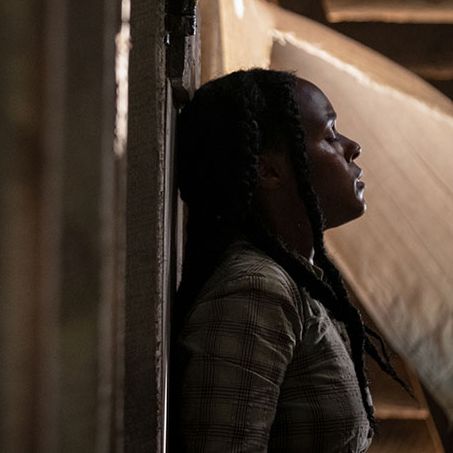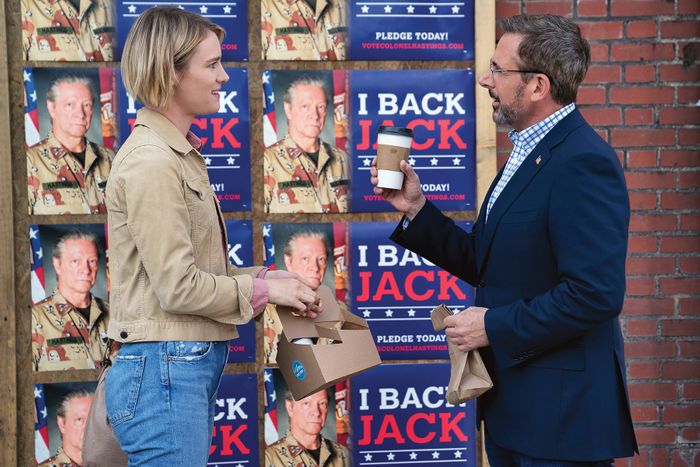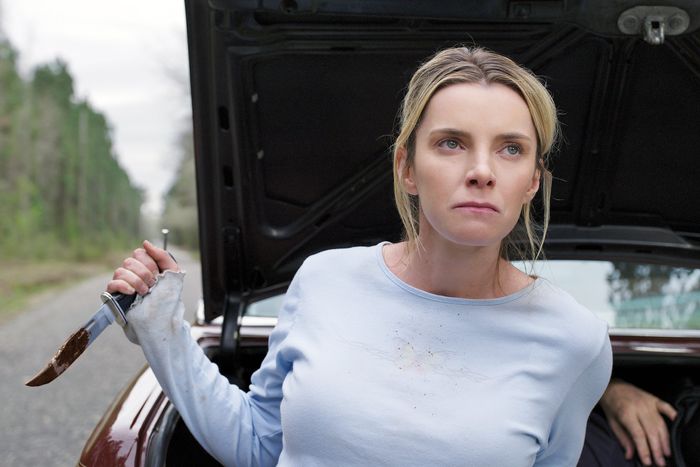
The movie Antebellum opens with an intricate tracking shot that winds through a southern slave plantation. It’s late afternoon, and the light slanting through the trees is as golden as the dress worn by a young girl picking flowers by the white-pillared main house. It’s an aggressively bucolic tableau meant to recall Gone With the Wind, complete with enslaved people bustling around the grounds alongside Confederate soldiers. Then the camera finds its way into a clearing, where an escape attempt is being viciously thwarted. A woman’s desperate sprint toward the tree line is presented in extravagant slow motion, capturing every panicked contortion of her face as she’s dragged to the ground and murdered. The violence is filmed with the same uncanny lushness as everything that has come before, seemingly to emphasize the horror that has always been at the heart of plantation nostalgia. The effect ends up being the opposite — an indulgence in the brutality of the moment, which the film has arranged to unfold during the aesthetically pleasing glow of magic hour.
For members of the media, Antebellum begins with a message from filmmakers Gerard Bush and Christopher Renz, priming the audience for what it is about to watch. Introductions to early screenings are not unheard of — work on something in a relative vacuum for months, and the vulnerability of finally putting it in front of strangers can prompt one to all sorts of last-minute efforts to reel in viewers. Antebellum, starring Janelle Monáe, had been building buzz since late 2019 with mysterious trailers that touted its connection to Get Out, with which it shares a pair of producers. The film had been slated for theaters before the pandemic pushed it to VOD, but Bush and Renz wanted to talk about more than just the scuppered big-screen release of their directorial debut. In the video, they bluntly proclaim their ambitions in making Antebellum, which were no less than to construct “the movie of and for this moment.”
Few directors rush to position their work as didactic, but Bush and Renz, who come from a background of advertising and PSAs, describe Antebellum as “medicine” tucked away in entertainment. It would, they hoped, start “a national dialogue around this country’s Lost Cause, the original sin of America,” and “illuminate some of those truths and confront them head-on, so that we can really move toward an actual healing.” It is a remarkable statement, especially given what a genuine disaster Antebellum is, so clumsy about the racial history it insists it wants to clarify and so inept in the basic mechanics of being a thriller that it verges on laughable. To frame a movie this way, before a single second of it has played, is such an act of unprompted hubris it’s almost endearing — and timely, though not in the way its filmmakers wanted. In the gap between the reality of Antebellum and its creators’ ambitions, there’s a sense that relevance has become a branding exercise as much as something that’s earned with the actual stuff of a film.
It’s the same feeling that arises when watching Jon Stewart’s Irresistible, a political satire about a mayoral race in a small town in Wisconsin — “the great now-swing state,” Steve Carell trumpets in the trailer — that becomes the focus of national attention after a former Marine goes viral for speaking up on behalf of immigrants in his community. The most telling scene plays over the end credits, when Stewart speaks with former U.S. Federal Election Commission chairman Trevor Potter. Calling it an interview is too generous — Potter is there to confirm that the plot’s pivotal campaign-finance scam is possible, but he’s not delivering the sound bites Stewart wants, so Stewart delivers them himself off-camera, leaving Potter to nod along and then affirm what he’s saying. It’s not unlike the preface Bush and Renz give to Antebellum — supplemental material meant to insist the accompanying film has a point it doesn’t manage to make during its run time.
That’s more than can be said for The Hunt, a movie that generated reams of heated coverage despite being about nothing in particular. The Blumhouse production centers on people who’ve been kidnapped to be tracked and killed for sport, and it became a big story after news leaked that the chosen prey are referred to by a character onscreen as “deplorables.” That rich liberals are the villains didn’t matter — The Hunt was the focus of a furious right-wing media cycle and some presidential tweets, all for a film that ultimately shrugs and declares both sides of the aisle bad. Its gestures toward pertinence amount to set dressing — literally, in the case of the photo of a character carrying a tiki torch at a march. When the film finally came to theaters in the spring, its studio tried to capitalize on the scandal with the tagline “The most talked about movie of the year is one that no one’s actually seen.” Lockdown cut its promotional cycle short before anyone could assess whether its efforts to treat all attention as good attention worked out.


Antebellum’s desire to say something about how we live now becomes clear only after its twist is revealed some 40 minutes in. There’s no way to discuss the film without spoiling it — the revelation doubles as the premise, which is that the plantation on which Monáe’s character, Veronica, is being held is one that exists not during the Civil War era but in the present day. Veronica is an author and high-profile academic who gives talks on intersectionality and argues on cable news, and she’s become the prize trafficking victim taken by a group of cosplaying white supremacists who like to pretend the 1860s never ended. That these reenactors have managed to keep a sizable group of captives secret and, apparently, complacent is a fact that the audience is just meant to accept. The film keeps the workings of its evil organization as vague as possible, which would be less maddening if it didn’t invite the audience to constantly wonder how it functions.
Antebellum sees itself as being in conversation with Gone With the Wind, even using some of the same camera lenses. But while it clearly wants to interrogate the role that 1939 movie has played in the romanticization of the antebellum South, it never figures out how to do it beyond giving everything the sheen of a perfume ad. As a condemnation of unreckoned-with history, it sheds no light on the psychology of its racist villains, formless cartoons who waver between seeming incredibly well connected and bumblingly ridiculous. As an exploration of the horrors of slavery, it’s a grotesque misfire — the contrivances of its present-day setting, and the film’s inexorable focus on rape, end up inadvertently portraying the monstrous institution as though it were a summer camp for incels. Even if Antebellum weren’t part of a long line of features dedicated to this historical atrocity, it’s never evident what the directors feel they’re bringing to the subject matter that other films have failed to.
Antebellum isn’t “the next Get Out,” though it clearly would like to bring Jordan Peele’s hit to mind. But it’s an indirect testament to how good Get Out is and how deftly it weaves together biting social commentary and genre structures. In comparison, these recent films linger in the vicinity of subjects like racism and political divides without actually making any points about them. They feel meaning-adjacent, or maybe just like products for an age of social media that has made headlines more important than the articles attached to them. Film isn’t a limber medium, and it isn’t the most innately responsive of formats, not with the time it takes for a feature to be written, funded, shot, and assembled. And yet we often want it to be, out of a desire to lend a sense of urgency to what we’re watching, developing more and more of a tendency — as moviegoers and as people who cover movies—to project timeliness onto things that might have been scripted years ago. It’s with a certain amount of serendipity, for …instance, that Antebellum arrives alongside renewed conversations about Gone With the Wind.
Criticism of GWTW’s whitewashing of slavery stretches back to its inception, but in June, after it turned up on the newly launched HBO Max, John Ridley wrote an op-ed in the L.A. Times. He requested the film be taken down until it could be given some kind of context. The streaming service acceded, adding a video prologue featuring TCM host Jacqueline Stewart. She talks about the film’s incredible popularity, its long history of being protested, how its Black cast members were unable to attend the premiere, and the complicated nature of its place in movie history. As responses to GWTW go, it was more prosaic than the stylized whole of Antebellum but also a lot more precise in its observations. It didn’t start the conversation, but it added to it — something that’s always going to be easier when you actually have something to say.
*This article appears in the September 14, 2020, issue of New York Magazine. Subscribe Now!


